|
|
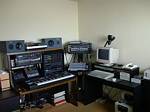
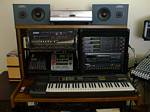
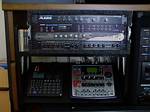
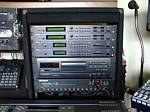
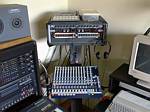
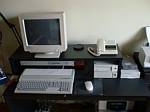
|
|
|
|
|






|
|
|
|
Red Light 6 Studio is located in
El Segundo, California (USA).
It is primarily an electronic music facility, but is quite capable
in the vocal and guitar recording departments as well. It is where the
electronic bands NURVIS and
Varactor Ratio
record all of their material. It is also used for many of my solo and collaborative efforts.
Some other bands that have recorded at Red Light 6 Studio, or are scheduled to record there in the near future, are Ceaven, Talking Tina, The Dickheads, eloquent, Kissing The Machine, Talent No More, and TIMOT.
The facility is also available for hire. If you are going to be in the Los
Angeles area, and are interested in making use of Red Light 6 Studio for your own projects, or for a collaboration,
please send me an e-mail so we can discuss it.
Red Light 6 Studio is centered around the Atari Falcon030 computer. Steinberg's Cubase Audio is the main software I run, which allows the Falcon to do MIDI sequencing, as well as 16 tracks of CD quality digital audio multitracking. I also make use of SoundPool's Audio Tracker software, for digital multitrack recording (as an alternative to Cubase Audio when needed). In addition, my particular Falcon is enhanced with Titan Design's Nemesis hardware accelerator, which speeds up all functions of the computer (although it isn't necessary for Cubase Audio or Audio Tracker to function). Audio quality is further improved by the use of the Steinberg / SoundPool FDI (Falcon Digital Interface). The FDI connects to the Falcon's DSP port, and gives the computer coaxial and optical digital inputs and outputs, allowing digital transfers to and from DAT or CD, in addition to allowing the use of outboard AD/DA converters - in my case those of the Tascam DA-20. Audio from the Falcon is then output through the Line Audio JAM 8 Out interface, which gives the Falcon 8 individual high quality 18-bit digital to analog converters, each with it's own individual 1/4 inch balanced analog output. Audio CD creation is done with a Yamaha 4416sz CD-RW drive, which utilizes Anodyne Software's CD Writer Plus package, allowing CD creation from DAT masters.
And of course, in addition to the Atari Falcon, I also utilize a self-built Windows 98SE based PC - sporting an 800MHz Pentium III processor, with 256MB or RAM. I currently use it to edit and manipulate sound files that are originally recorded on the Falcon, as well as to create mp3s of my work. For this, I make use of Cool Edit 2000, and
Audio Catalyst.
Continuing on with the studio setup, the Falcon is then connected to a Behringer Eurorack MX 2642A 26 input 4-bus mixing console. This console is in turn connected to the aforementioned Tascam DA-20 DAT, and a TEAC V-570 cassette deck. From there, any audio can be run through the following processors:
And last but certainly not least, is the gear I use to generate all the
wonderful electronic sounds I crave:
And then there are the essential tools like the:
Finally, Red Light 6 Studio continues to grow and mature, with many new improvements planned for the very near future. As a start, the studio recently completed it's move to a larger room (the new pictures were taken shortly after that move), and was combined with a friend's guitar-based studio, to create an even better and more complete recording facility.
And of course, in addition to the equipment listed here, access to specific microphones, guitars and
other outboard gear is available. And I also offer my services as a keyboard and drum machine
player / programmer if needed. Please drop me a line if you have any questions about
Red Light 6 Studio, such as technical information about the equipment, or studio availability.
|